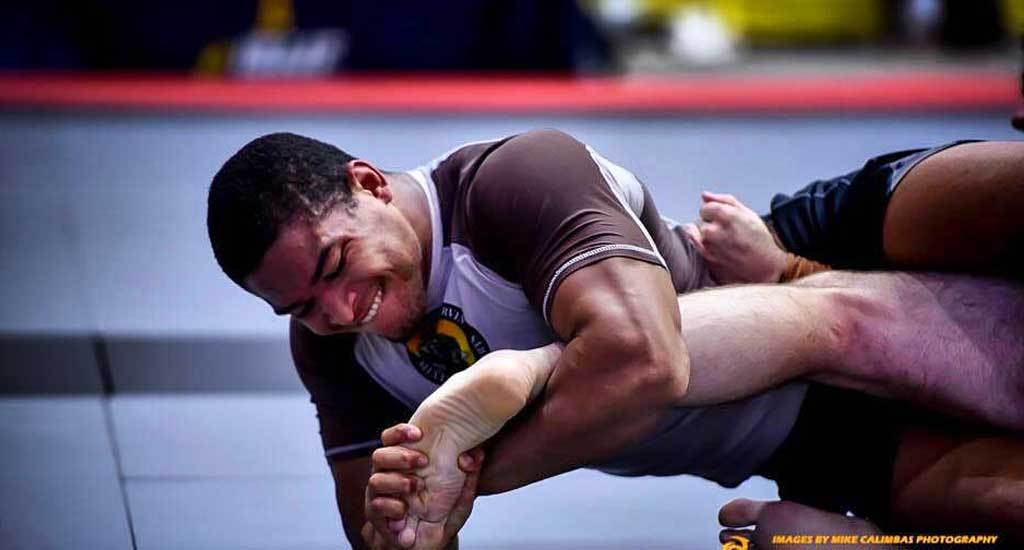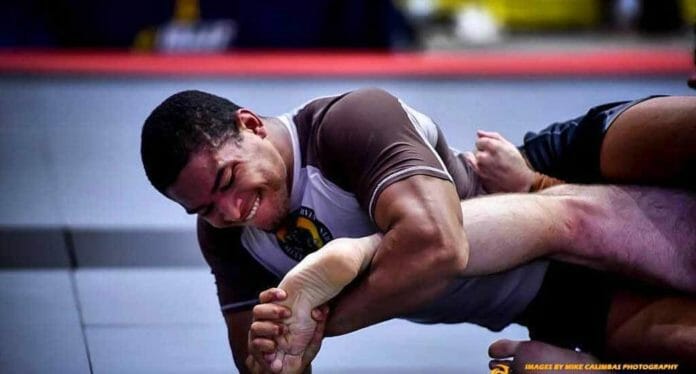If you keep up with the BJJ metagame, you know that BJJ leg locks are ‘in’ and here to stay. Particularly in no gi BJJ, leg locks are a prominent technique in both points rules, submission only, and MMA. Originally, leglocks were frowned upon in mainstream BJJ competition. However, these days, if you want to have any chance at actually winning in mid- to high-level no gi BJJ, you have to study leg locks.

What is a BJJ Leg lock?
Leg locks in BJJ encompass a range of submissions that attack any of the joints below the waist. These include the ankle, knee, and hip joints. Due to the body positions needed to apply leg locks, leg lock entanglements stray from the classic positions in BJJ such as side control, mount, and the back.
As such, the traditional scoring system in IBJJF rulesets is not a great way to assess the competencies of a leg locker. In fact, many good leg lockers may not even bother trying to pass guard and go through the traditional control series. This is because most leg locks cannot be applied from traditional BJJ control positions.
The History of Leglocks in BJJ
Far from being a new technique, the history of leg locks dates back to ancient hand-to-hand combat forms such as Greek pankration. In this Roman engraving, a centaur is depicted applying what appears to be a heel hook to a naked grappler. So much for 50-50 being a modern BJJ position!

As recently as the 1990s, leg locks were frowned upon in mainstream BJJ competition. For example, in his interview on the Jocko Willink podcast, Dean Lister, widely known for being the popularizer of leg locks in modern BJJ, recalls being booed in Brazil when he submitted his opponents with straight ankle locks. Lister is well-known for his quote about attacking the legs: “why would you ignore 50 percent of the human body?”
Why would you ignore 50 percent of the human body?
-Dean Lister
At this point, BJJ legends such as John Danaher and Eddie Bravo have cemented leglocks into the BJJ metagame – and typically credit Lister for destroying the stigma (along with his opponent’s feet).
From local tournaments to world-championship titles, you’re almost guaranteed to see BJJ leg lock exchanges in modern No Gi competition.
The Top Leg Lock Techniques in BJJ
If you want to have a shot at winning in BJJ – especially in no gi – you need to be well-versed in the following BJJ leg lock techniques.
Straight Ankle Locks
Straight ankle locks are typically the first leglock you will learn. They are legal at most levels of competition in both Gi and No Gi. You can apply the standard straight ankle lock from the ashi garame position. The straight ankle lock is considered a ‘safe’ leglock since you’ll feel pain before any real damage is done.
The Damage from Straight Ankle Locks
Straight ankle locks attack the ankle joint and attempt to hyperextend the foot, which can strain the tendons and ligaments and the ankle and potentially fracture the ends of the ankle bone. If your ankle ‘pops’ during a straight ankle lock, you may be out for several weeks to a month, and will likely need some form of rehab.
Knee Bars
Knee bars are a BJJ leglock that attacks the knee by hyperextension. Your knee is designed to bend one way – a knee bar bends in the other way. Depending on your flexibility and the setup of the bar, you may feel a serious stretch in your hamstring or the pressure directly into your knee.
You can attack with a knee bar from a variety of positions; however, you’ll typically be facing away from your opponent with a leg trapped between your two legs. From there, you will secure your opponent’s leg with your upper arms and extend through your hips to apply serious pressure to the opponent’s knee. The mechanics of the knee bar are very similar to the arm bar.
Heel Hooks

Heel hooks are really the top-of-the-game when it comes to BJJ leglocks. Despite the name, the heel hook primarily attacks the knee joint. As we mentioned, the knee only bends in one direction. However, unlike the knee bar, a heel hook attacks the knee via a rotational force. Since the knee cannot mechanically rotate either way, rotational force in either direction causes an insane amount of damage to the ligaments that connect your lower leg to your upper leg.
Heel hooks are applied from several different leg entanglements including the ‘honey-hole,’ ’50-50,’ and ‘ashi garame’ positions. Leglock ‘shootouts’ typically involve competitors battling for dominant positioning in one of these entanglements. As we will discuss further on, these positions place both the attacker and defender in danger of getting leg locked.
In leg lock battles, it’s common for the player pushing the entanglement to get countered by the very submission they were hoping to set-up.
The Damage of Heel Hooks
Heel hooks can strain, sprain, or completely sever the ACL, MCL, and LCL ligaments in the knee. One of the reasons they are considered “dangerous” is that you don’t feel a ton of pain until the damage has been done.
That said, once you’re familiar with the sensation of being heel hooked, you’ll know right away when its time to tap. Unlike the pain of an arm bar, the sensation of a heel hook with make you cringe and clench your you-know-what once you grasp the potential devastation of refusing to tap.
An additional note on heel hooks – the recovery for a fully torn or even sprained ACL can involve serious surgery followed by months of rehabilitation. Furthermore, there is a good chance your knee will never quite be the same. Heel hooks are no joke.
Of course, heel hooks can absolutely be safely trained and applied in both practice and competition, and the risk of injury is low – provided you tap when its time.
Toeholds

A toe hold is a variety of foot lock that involves getting a figure-four grip on your opponent’s foot while controlling the leg. Toeholds are often called ‘twisting foot locks’ because unlike a straight ankle, the breaking mechanic is a rotation and inversion as opposed to a hyperextension.
Toeholds are fairly easy to attempt but difficult to finish. However, threatening a toehold is a great way to get your opponent to react in the midst of a BJJ leg lock battle. His reaction may allow you to get a better position or set up another submission.
The Damage from Toe Holds
While not as brutal as heel hooks, a fully applied toehold results in a potentially serious sprained or broken ankle. The recovery will usually be a few months. Once again, toeholds are safe provided you tap in time.
Calf and Hip Locks
Calf crushers and hip locks are offshoots of leg locks common to No Gi systems such as 10th Planet Jiu Jitsu. Calf crushers such as the ‘vaporizer’ function by hyperextending the foot and applying pressure into the flexed calf muscle. This can result in hyperextension of the ankle and muscular damage to the calf. The vaporizer causes a lot of pain before any real damage is done, and is fairly easy to counter.
Hip locks are leg locks that attack the groin. These include submissions such as the ‘banana-split’ and ‘electric chair,’ both of which originated in the 10th Planet system but are now popular submissions amongst most No Gi players. These leg locks rely on spreading the legs in a ‘splits’ position either side-to-side or front to back. You will feel a serious stretch and risk a groin tear if you do not tap. They can be hard to finish on flexible BJJ players.
The Risks of Attacking the Legs in BJJ
With most BJJ submissions, you’ll generally have some form of dominant position before attacking. With traditional top-game or back control, by the time you’re attacking a submission, the opponent will generally have a few steps to work their way back to a decent position.
For example, with a rear-naked choke, your opponent has to defend the choke and escape the back position before they can begin imposing their own game. Unless they catch you with something stupid like a wrist lock or your feet crossed while you’re on their back, there’s a fairly low chance of them turning the position around and submitting you.
The opposite is true with leg locks. When you attack a heel hook from a leg entanglement, you are sometimes a simple grip away from getting heel hooked yourself. With a quick leg re-weave, a crafty opponent might submit you seconds after you go for the entanglement.
As one of my coaches frequently says, “when it comes to leg locks, you have to put a quarter in to play the game.” As such, you have a very small margin for error if you’re attacking the legs of someone with decent knowledge of BJJ leg locks.
How to Learn Leg Locks in BJJ
The biggest key to getting good at leg locks in BJJ is learning the ins-and-outs of the leg entanglement positions. You need to have a good understanding of the ashi garame variations, the honey-hole, and the 50-50 entanglements, to name a few. Randomly diving for a leg lock without knowledge of the entanglements will not allow you to consistently finish leg locks. Furthermore, against players with leg knowledge, you are really just digging your own grave.
Start by learning the fundamentals of ashi garame and Single-leg X. From there, practice transitioning between ashi, honey-hole, and 50-50 variations until you are comfortable flowing between positions. We highly recommend seeking out an instructor with leg lock knowledge. It’s also worth watching some leg lock instructional lessons to learn the fundamentals of BJJ leg locks.
Get comfortable finishing straight ankle locks before diving into heel hooks. Furthermore, always take care of your partner and never crank down on a heel hook during training – you might injure your partner and will not develop the deeper details to finish leg attacks on high-level grapplers.
In Conclusion: Start Learning BJJ Leg Locks Today!
If you are serious about having a well-rounded BJJ game, you must develop your BJJ leg lock skills. Whether your goal is to win championships, local tournaments, or just have a respectable knowledge of grappling, leg locks are a must.
Take proper care of your partners, don’t be afraid to tap, and get to leg locking!





